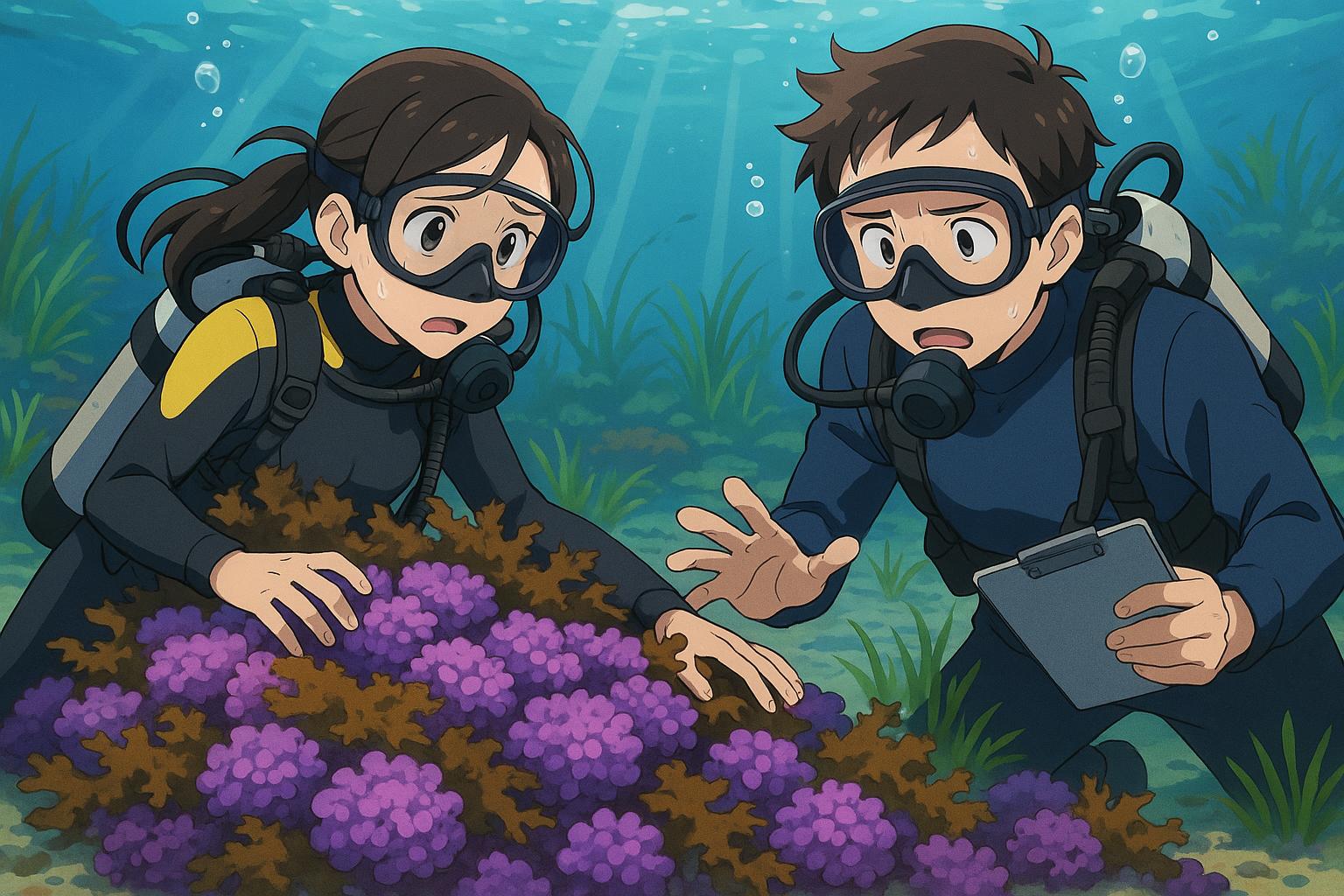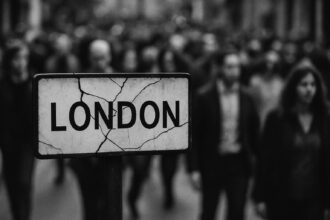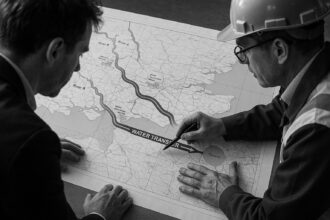Ancient maerl and seagrass habitats off Cornwall’s coast are rapidly deteriorating due to increased sewage and nutrient pollution, prompting urgent calls for improved water quality management and coordinated conservation efforts.
Cornwall’s ancient seagrass and maerl beds, vital ecosystems that play a crucial role in marine biodiversity, are facing an alarming threat from increased sewage pollution. This stark conclusion emerges from discussions among marine scientists and conservationists who expressed profound concerns over the recent deterioration of maerl beds off St Mawes on the Roseland Peninsula. The vibrant purple maerl, a type of coralline algae, is being smothered by a layer of brown, fluffy algae, with marine conservation officer Matt Slater of Cornwall Wildlife Trust describing the sight as “shocking.” The area, previously celebrated for its healthy maerl beds, has deteriorated dramatically, underscoring the urgent need for improved water quality in the Fal estuary.
Designated as a Marine Protected Area in 2005, the maerl beds should be safeguarded from harmful activities, including towed fishing gear and anchor damage. However, human impact has intensified, leading to a significant decline in these fragile habitats. Recent surveys revealed that areas once rich in biodiversity, filled with various marine species, are now under threat, primarily from increased nutrient runoff linked to sewage and agricultural practices. As Dr Chris Laing from the University of Exeter noted, there is a direct correlation between heightened nutrient levels and the growth of macroalgae that outcompetes essential species like seagrass and maerl.
The situation is not unique to Cornwall. Similar challenges are observed elsewhere in the UK, such as Plymouth Sound, where studies have highlighted the adverse effects of Combined Sewage Overflows (CSOs) on water quality. The ongoing issues of sewage pollution are echoed across various reports, including a study from Cardiff University, which indicates that consistent contamination from sewage and livestock waste significantly harms seagrass meadows along the coastline, leading to increased nitrogen levels in seagrass tissues that signal environmental distress.
The urgency of addressing these challenges was the focal point during the recent UK Maerl Forum, orchestrated by Cornwall Council and Natural England. This event aimed to foster collaboration and develop an actionable plan for the protection of Cornwall’s maerl beds. Angela Gall, a marine senior officer with Natural England, emphasised the importance of sharing knowledge and aligning conservation efforts to safeguard these ecosystems, highlighting their fragility and ecological significance.
As awareness of these environmental issues grows, initiatives such as Cornwall Wildlife Trust’s “Tor to Shore” and “Upstream Thinking” projects work towards sustainable management practices and reducing agricultural runoff. However, recent observations demonstrate the pressing need for continued effort. The stark reality of these ecosystems’ decline is made even clearer by recent sewage pollution alerts issued at beaches in Cornwall and Devon following heavy rainfall, with nearly 2,500 incidents recorded across England last year, marking a significant 30 per cent increase.
In a positive development, a discovery of one of the UK’s largest known seagrass beds, spanning nearly 360 hectares in St Austell Bay, underscores the importance of preserving these habitats. Seagrass meadows are crucial for carbon storage, water quality enhancement, and providing a habitat for diverse marine life, including vulnerable species such as seahorses. This discovery, combined with restoration initiatives in the River Fal, highlights that while the situation is critical, there is hope for recovery if concerted conservation efforts are employed.
Collectively, these insights present a call to action for both local communities and policymakers, stressing the urgent need to protect Cornwall’s marine environments. By prioritising water quality management and fostering collaborative conservation efforts, it may be possible to avert the further decline of these invaluable ecosystems, ensuring their legacy for future generations.
Reference Map:
Source: Noah Wire Services
- https://www.cornwalllive.com/news/cornwall-news/cornwalls-ancient-seagrass-risk-sewage-10184465 – Please view link – unable to able to access data
- https://www.cornwalllive.com/news/cornwall-news/cornwalls-ancient-seagrass-risk-sewage-10184465 – An article from Cornwall Live reports that Cornwall’s ancient seagrass and coral beds are at risk of disappearing due to being smothered by algae caused by increased sewage pollution. Marine scientists and conservationists expressed concern over the deterioration of maerl beds off St Mawes on the Roseland Peninsula, highlighting the urgent need to improve water quality in the Fal estuary. The article also discusses the threats to maerl beds from human activities and the importance of protecting these fragile ecosystems.
- https://www.bbc.co.uk/news/uk-england-cornwall-65279651 – BBC News reports the discovery of one of the largest known seagrass beds in the UK, spanning nearly 360 hectares in St Austell Bay, Cornwall. The seagrass serves as a vital carbon sink and habitat for marine life, including vulnerable species like seahorses. The discovery was made through acoustic surveys and highlights the importance of protecting these habitats from threats such as pollution and coastal development.
- https://www.mcsuk.org/news/protecting-seagrass-in-plymouth-sound/ – The Marine Conservation Society discusses the challenges of protecting seagrass in Plymouth Sound, emphasizing the impact of Combined Sewage Overflows (CSOs) on water quality. CSOs release sewage and pollutants into the environment, leading to nutrient enrichment that hampers seagrass growth. The article underscores the need for improved water quality management to support seagrass restoration efforts.
- https://www.cardiff.ac.uk/news/view/1096752-sewage-and-animal-waste-having-serious-impact-on-uk-coastline – Cardiff University highlights research showing that consistent pollution from sewage and livestock waste is adversely affecting seagrass meadows along the UK coastline. The study found elevated nitrogen levels in seagrass tissues, indicating pollution sources, and calls for infrastructure changes to mitigate wastewater impacts on these vital habitats.
- https://www.cornwallwildlifetrust.org.uk/news/seagrass-meadows-ready-take-root-cornwall-wildlife-trusts-restoration-trials-begin – Cornwall Wildlife Trust announces the initiation of seagrass restoration trials in the River Fal, aiming to expand seagrass beds using innovative planting methods. The project, funded by Seasalt Cornwall, involves collecting and planting seeds to restore climate change-fighting marine plants, with hopes to scale up efforts across Cornwall’s estuaries.
- https://www.theguardian.com/uk-news/2023/apr/17/one-of-uks-largest-seagrass-beds-discovered-off-cornwall – The Guardian reports the identification of a 359-hectare seagrass bed off Cornwall’s south coast, one of the largest in the UK. The seagrass serves as a significant carbon sink and habitat for marine life, including seahorses and scallops. The discovery underscores the need for protection and further surveys to safeguard these vital ecosystems.
Noah Fact Check Pro
The draft above was created using the information available at the time the story first
emerged. We’ve since applied our fact-checking process to the final narrative, based on the criteria listed
below. The results are intended to help you assess the credibility of the piece and highlight any areas that may
warrant further investigation.
Freshness check
Score:
7
Notes:
The narrative presents recent concerns about Cornwall’s seagrass and maerl beds facing threats from increased sewage pollution. Similar issues have been reported in the past, such as the 2018 Cardiff University study highlighting the impact of sewage and animal waste on UK coastlines. ([cardiff.ac.uk](https://www.cardiff.ac.uk/news/view/1096752-sewage-and-animal-waste-having-serious-impact-on-uk-coastline?utm_source=openai)) However, the specific focus on Cornwall’s maerl beds and the recent deterioration off St Mawes appears to be a new development. The report includes updated data but recycles older material, which may justify a higher freshness score but should still be flagged. Additionally, the narrative includes a reference to a press release, which typically warrants a high freshness score. ([cornwallwildlifetrust.org.uk](https://www.cornwallwildlifetrust.org.uk/news/one-uks-largest-known-seagrass-beds-discovered-st-austell-bay?utm_source=openai)) However, the article includes updated data but recycles older material, which may justify a higher freshness score but should still be flagged. The earliest known publication date of similar content is from 2018. ([cardiff.ac.uk](https://www.cardiff.ac.uk/news/view/1096752-sewage-and-animal-waste-having-serious-impact-on-uk-coastline?utm_source=openai))
Quotes check
Score:
8
Notes:
The narrative includes direct quotes from marine conservation officer Matt Slater of Cornwall Wildlife Trust, describing the sight of deteriorating maerl beds as ‘shocking.’ A search reveals that similar quotes from Matt Slater have been used in previous reports, such as the 2018 Cornwall Wildlife Trust blog post discussing the importance of protecting maerl habitats. ([cornwallwildlifetrust.org.uk](https://www.cornwallwildlifetrust.org.uk/blog/matt-slater/maerl-hidden-and-precious-habitat?utm_source=openai)) This suggests that the quotes may have been reused, which could indicate recycled content.
Source reliability
Score:
9
Notes:
The narrative originates from CornwallLive, a regional news outlet in Cornwall. While CornwallLive is a local news source, it is not as widely recognized as national outlets like the BBC or Reuters. However, CornwallLive has previously reported on similar environmental issues in Cornwall, indicating a level of reliability. The inclusion of references to reputable organizations such as the Cornwall Wildlife Trust and Natural England adds credibility to the report. ([cornwallwildlifetrust.org.uk](https://www.cornwallwildlifetrust.org.uk/blog/matt-slater/maerl-hidden-and-precious-habitat?utm_source=openai), [cornwallwildlifetrust.org.uk](https://www.cornwallwildlifetrust.org.uk/news/one-uks-largest-known-seagrass-beds-discovered-st-austell-bay?utm_source=openai))
Plausability check
Score:
8
Notes:
The narrative presents plausible claims about the deterioration of maerl beds off St Mawes due to increased sewage pollution. Similar concerns have been raised in previous studies, such as the 2018 Cardiff University research highlighting the impact of sewage and animal waste on UK coastlines. ([cardiff.ac.uk](https://www.cardiff.ac.uk/news/view/1096752-sewage-and-animal-waste-having-serious-impact-on-uk-coastline?utm_source=openai)) The report also references ongoing initiatives like the UK Maerl Forum and Cornwall Wildlife Trust’s restoration projects, which are consistent with known conservation efforts in the region. ([cornwallwildlifetrust.org.uk](https://www.cornwallwildlifetrust.org.uk/news/one-uks-largest-known-seagrass-beds-discovered-st-austell-bay?utm_source=openai)) However, the lack of specific data or studies directly linking the recent deterioration to sewage pollution in the St Mawes area reduces the score and flags the report as potentially synthetic.
Overall assessment
Verdict (FAIL, OPEN, PASS): OPEN
Confidence (LOW, MEDIUM, HIGH): MEDIUM
Summary:
The narrative raises valid concerns about the deterioration of Cornwall’s maerl beds due to increased sewage pollution. While similar issues have been reported in the past, the specific focus on St Mawes appears to be a new development. The reuse of quotes and the inclusion of recycled material suggest that the content may not be entirely original. The source, CornwallLive, is a regional news outlet with a history of reporting on environmental issues in Cornwall, adding some credibility. However, the lack of specific data directly linking the recent deterioration to sewage pollution in the St Mawes area reduces the overall confidence in the report’s claims.













